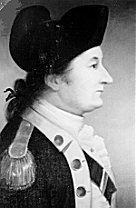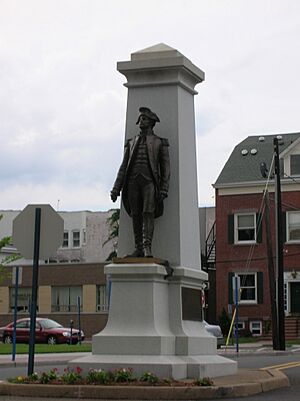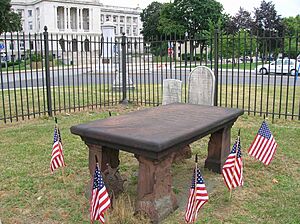Enoch Poor facts for kids
Quick facts for kids
Enoch Poor
|
|
|---|---|

Painting by Ulysses Dow Tenney, 1873, after an earlier portrait by Tadeusz Kościuszko
|
|
| Born | June 21, 1736 Andover, Massachusetts |
| Died | September 8, 1780 (aged 44) Hackensack, New Jersey |
| Buried |
Hackensack, New Jersey
|
| Allegiance | |
| Service/ |
|
| Years of service | 1775–1780 |
| Rank | |
| Battles/wars | American Revolutionary War |
| Spouse(s) | Martha Osgood |
| Other work | Ship builder, merchant |
Enoch Poor (born June 21, 1736 – died September 8, 1780) was an important leader in the Continental Army. He served as a brigadier general during the American Revolutionary War. Before becoming a soldier, he was a successful ship builder and merchant in Exeter, New Hampshire.
Contents
Early Life and Military Beginnings
Enoch Poor was born and grew up in Andover, Massachusetts. His father, Thomas Poor, was a soldier too. He fought in a battle in 1745 to capture Louisburg, Nova Scotia. This happened during a conflict called King George's War.
In 1755, Enoch Poor joined the army as a private. He was part of a Massachusetts group. They went with General Jeffery Amherst to take back Louisburg. This was during the French and Indian War. His unit also helped with the expulsion of the Acadians. After this war, he returned home to Andover.
Poor soon married Martha Osgood. They moved to Exeter, New Hampshire. There, he became a very successful ship builder.
Joining the American Revolution
Enoch Poor believed in American independence early on. He supported the colonists during the Stamp Act protests in 1765. He worked on different committees in Exeter. These groups helped organize the growing rebellion against British rule.
In 1775, Poor was chosen twice for the provincial Assembly. When the Battle of Lexington happened, the assembly asked for three groups of militia soldiers. Poor became the leader, or colonel, of the 2nd New Hampshire Regiment.
Other regiments went to Boston, but Poor's group stayed in Portsmouth and Exeter. They moved to Boston after the Battle of Bunker Hill on June 25. Later in 1775, Poor's unit joined the main Continental Army. They were sent north with General Richard Montgomery for the invasion of Canada.
Leading Troops in Battle
After a difficult time in Canada, Poor led the remaining soldiers of his regiment. In early 1776, they returned to Fort Ticonderoga. His unit was then renamed the 8th Continental Regiment. In December 1776, they joined George Washington's main army. They spent the winter near Morristown, New Jersey.

On February 21, 1777, the Continental Congress made Poor a brigadier general. That spring, his group of soldiers went back to Ticonderoga. They had to retreat with General Arthur St. Clair's forces on July 5. Moving south, they met General Horatio Gates before the Battle of Saratoga. Poor's group grew bigger with two more regiments from Connecticut.
Battles of Saratoga
In the Battle of Freeman's Farm, Poor's soldiers were the first to help Daniel Morgan's attack. Poor's group held the American left side. They stretched into the woods and even went around the British soldiers. They fought well, keeping General Simon Fraser's soldiers busy. This allowed Benedict Arnold to lead attacks on the British center.
In the Battle of Bemis Heights, Poor's group was part of General Benjamin Lincoln's division. They were on the western end of the American line. They were closest to the advancing British soldiers. They came under fire from the British grenadier battalion. The British fire was not effective. So, Major John Dyke Acland led his grenadiers in a bayonet charge.
Poor waited until the British were very close. Then, his 1,400 men fired all at once. These were the first American shots in this battle. The British charge completely broke apart. Acland himself was wounded. With the British center collapsing, the Americans captured Acland and Major Williams. They also took the British cannons. Poor then helped Ebenezer Learned and Morgan's soldiers.
Later Campaigns and Death
Poor's group spent another winter with the main army. This time, they were at Valley Forge. He led the final movements in the Battle of Monmouth on June 28, 1778. In 1779, he joined the Sullivan Expedition. He led a group of soldiers to victory at the Battle of Newtown.
After these battles, Poor was assigned to Lafayette's division. He mostly performed guard duty in New Jersey. Some stories say Poor was shot in a duel near Hackensack, New Jersey, on September 6, 1780. He died two days later from the wound. However, the Army doctor reported that he died from typhus, a type of fever.
He was buried in the First Reformed Dutch Church Cemetery in Hackensack. Both George Washington and Lafayette went to his funeral. Washington wrote to Congress about Poor's death. He said that Poor "was an officer of distinguished merit, one who as a citizen and soldier had every claim to the esteem and regard of his country."


